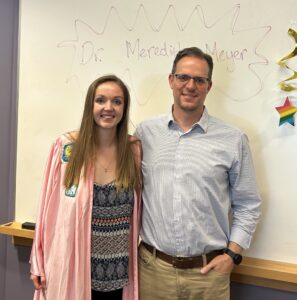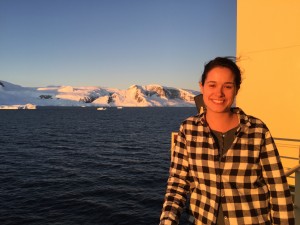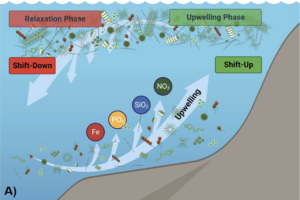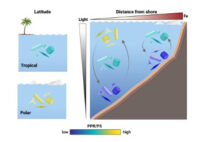April 18, 2024

Meredith successfully defended her Ph.D dissertation titled ‘The Influence of Phytoplankton Productivity and Molecular Physiology on Biogeochemical Dynamics of Two Contrasting Ocean Environments’. Meredith examined primary productivity dynamics as part of the NASA EXPORTS program field campaigns in the North Pacific and North Atlantic. She used a combination of physiological and molecular methods to elucidate how phytoplankton respond to their environment and influence the export of carbon from the surface ocean. She also conducted laboratory studies on Bathycoccus, an important picoeukaryote from the North Pacific. Meredith will be starting a post-doc at the University of East Anglia this summer.
March 22,2024

Congratulations to Prisca Lim who defended their M.Sc. thesis titled ‘Drivers of marine phytoplankton diversity and connectivity in the Galápagos Archipelago spanning an ENSO cycle’. Prisca analyzed DNA sequences from our Galápagos cruises from 2014 – 2022 spanning the El Niño in 2015/16 and the La Niña event from 2020-2022. Phytoplankton composition and size structure are highly dependent on the environmental conditions across the region which exhibit both high spatial and temporal variability. Publication soon to follow.
February 27, 2024

Former PhD student Carly Moreno has led a study just published in mSystems examining how diatom natural assemblages respond to changes in environmental conditions in waters adjacent to the Western Antarctic Peninsula using metatranscriptomic approaches. She also opportunistically examined a bloom of the centric diatom Actinocyclus in coastal waters.
Molecular physiology of Antarctic diatom natural assemblages and bloom event reveal insights into strategies contributing to their ecological success
February 24, 2024
 Ph.D student Johnson Lin is the lead author on a study recently published in Limnology and Oceanography where we examined how diatoms respond to upwelling when under various iron states at narrow and wide shelf regions in the California Current System.
Ph.D student Johnson Lin is the lead author on a study recently published in Limnology and Oceanography where we examined how diatoms respond to upwelling when under various iron states at narrow and wide shelf regions in the California Current System.
Variability in the phytoplankton response to upwelling across an iron limitation mosaic within the California current system
October 1, 2023
This NSF-funded project includes UNC PIs Adrian Marchetti and Harvey Seim, with collaborators Monique Messié at the Monterrey Bay Aquarium Research Institute (MBARI) and Diego Figueroa at University of Texas Rio Grande Valley (UT-RGV), who will use ship-based field sampling, a mooring, laboratory culture experiments and numerical modeling to examine how variations in nutrient delivery impact marine plankton in the Galápagos Archipelago.
The influence of different nutrient delivery modes on functional biodiversity of marine plankton in a changing ocean
UNC article about this project
There is a graduate student position available for this project. For additional information, go here.
September 28, 2023
Former undergraduate student Emily Pierce led a publication on comparing different methods for identification of diatoms in dynamic coastal communities. In this study, Emily compared 18s rRNA gene analysis with FlowCam imaging and light microscopy. Her findings show some consistencies, although cross-method comparisons should proceed with caution.
Comparison of advanced methodologies for diatom identification within dynamic coastal communities
September 18, 2023
 Our study on proton-pumping rhodopsins (PPR) in Southern Ocean phytoplankton was just published in the Proceedings of the National Academy of Sciences. Led by former post-doc Sarah Andrew, we show that PPR in Southern Ocean diatoms is located in the vacuole, making it an alternative phototrophic organelle to the chloroplast. Energy produced by PPR increases under cold, low iron and high light conditions when photosynthetic rates are at their lowest. We found high expression of PPR genes and concentrations of retinal (the pigment used in PPR) in phytoplankton collected from environmental samples collected in waters surrounding the West Antarctic Peninsula.
Our study on proton-pumping rhodopsins (PPR) in Southern Ocean phytoplankton was just published in the Proceedings of the National Academy of Sciences. Led by former post-doc Sarah Andrew, we show that PPR in Southern Ocean diatoms is located in the vacuole, making it an alternative phototrophic organelle to the chloroplast. Energy produced by PPR increases under cold, low iron and high light conditions when photosynthetic rates are at their lowest. We found high expression of PPR genes and concentrations of retinal (the pigment used in PPR) in phytoplankton collected from environmental samples collected in waters surrounding the West Antarctic Peninsula.
Link to PNAS article here
Link to layperson summary on Kudos here
September 16, 2022
Our first paper contribution to the NASA EXPORTS program was recently published in Elementa: Science of the Anthropocene. In this study, Ph.D. candidate Meredith Meyer provides our findings on trends in new and regenerated production during the North Pacific EXPORTS field campaign. Meredith and coauthors show that the majority of net primary production (NPP) is performed by small cells growing on regenerated sources of nitrogen. Yet, any variations in NPP are primary driven by changes in nitrate-based new production.
Phytoplankton size-class contributions to new and regenerated production during the EXPORTS Northeast Pacific Ocean field deployment
May 18, 2022
Our second publication investigating the protistan communities in the Galápagos Archipelago was published recently in Frontiers in Marine Sciences. Former post-doc Se Hyeon jang led this effort to examine how environmental conditions influence marine protists with an emphasis on the micrograzer communities. We also report observation from a red tide bloom in Elizabeth Bay, Isabela Island. A bloom of the dinoflagellate Scripsiella lachrymosa was being actively grazed by another dinoflagellate, Polykrikos kofoidii.
Protistan communities within the Galápagos Archipelago with an emphasis on micrograzers
Dec. 19, 2021
Our new publication led by former graduate student Erika Neave was recently published in Environmental Microbiology. This publication is the first highlighting my groups research in the Galápagos Archipelago where we participated on annual research cruises that spanned the 2015/16 El Niño event. In this study, we found that the composition of the marine protist community was significantly influenced by deep water masses. This suggests that the ocean currents are a major source of plankton seed populations to the surface waters in the Galápagos and thus substantially influences plankton composition when these currents change as a result of El Niño-Southern Oscillation (ENSO) events.
Protistan plankton communities in the Galápagos Archipelago respond to changes in deep water masses resulting from the 2015/16 El Niño






University Operator: (919) 962-2211 | © 2024 The University of North Carolina at Chapel Hill |